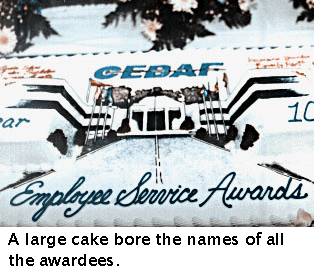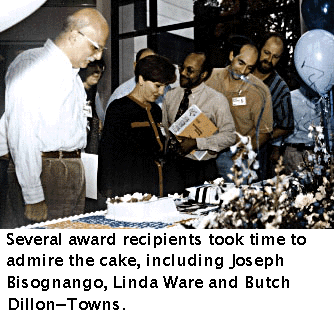- Hall C Fills Niche
- Facts
- Keeping it Cool
- Rutgers University Spearheads Focal Plane Polarimeter Project
First Experiment Begins
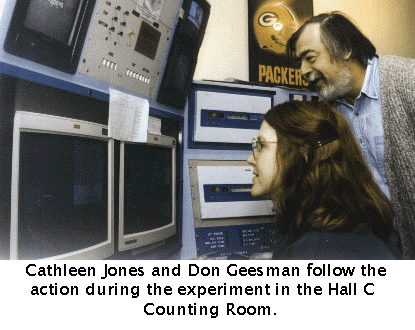
On November 15th it all came together. The teamwork, ingenuity, and dedication of countless CEBAF users and staff resulted in the successful "christening" of Hall C. With the start of the first experiment, the laboratory enters a new era of exploration never realized before.
Experiment team leader Don Geesaman, a nuclear physicist from Argonne National Laboratory in Illinois, remarked that the experiment's magnitude demanded the expertise of many. "This is a group effort. No one person even knows 50 percent of the overall project. The challenge is bringing the right combination of people together. Everyone contributed," says Geesaman.
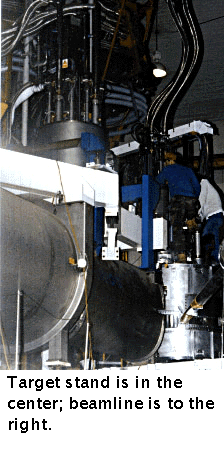 Over 100 scientists have contributed to the experiment's development and implementation. Many of the researchers previously conducted the experiment at Stanford Linear Accelerator Center. Geesaman says that data collected at CEBAF will be superior to earlier attempts of the experiment. This is due to the excellent properties of the laboratory's continuous beam and greater accuracy of CEBAF's spectrometers. Geesaman has also been impressed with the quality of CEBAF staff and equipment.
Over 100 scientists have contributed to the experiment's development and implementation. Many of the researchers previously conducted the experiment at Stanford Linear Accelerator Center. Geesaman says that data collected at CEBAF will be superior to earlier attempts of the experiment. This is due to the excellent properties of the laboratory's continuous beam and greater accuracy of CEBAF's spectrometers. Geesaman has also been impressed with the quality of CEBAF staff and equipment.
"CEBAF has a large group of talented, dedicated people working on the experiment. I have been very pleased with the reliability of the accelerator. The beam has been excellent. The startup was slow, but that is the way things usually work. After startup, everything just seemed to click along," says Geesaman. Researchers analyze data as it is collected and will continue to do so in greater depth over the next year. Data collected may provide groundbreaking insights into the nature of nuclear matter. The results could seriously challenge previously held scientific models. To facilitate this, researchers are probing various target materials with a stream of electrons produced by CEBAF's accelerator.
After several circuits through the race-track shaped accelerator, the hair-width beam is released into Hall C where it collides into gold, carbon, and iron foil targets. Some of the beam's electrons will interact with the target's protons as beam passes through the foil causing target protons to break away. Ninety-nine percent of the beam's electrons pass through the target without any interaction. "When an electron does strike a proton in the center of the nucleus, about 30 percent of the time protons emerge without interacting with other protons or neutrons in the nucleus," says Geesaman. Spectrometers measure parameters of the interactions like the speed, mass,and direction of target protons displaced by the beam's electrons.
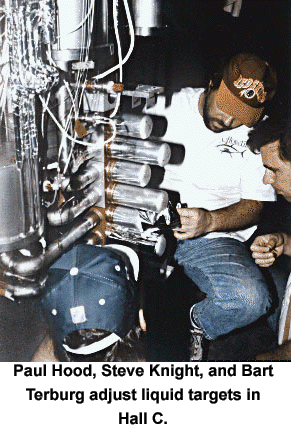 Using a simple ice-skating scenario the interaction can be visualized as follows:
Using a simple ice-skating scenario the interaction can be visualized as follows:
If a large skater collides with great force into a tightly packed group of skaters, members within the group will spin off due to collision forces exerted by the colliding skater. Skaters in the group would be displaced in varying degrees and distances based on their proximity to the point of collision and their individual weights and momentum. Many in the group though would not be displaced if distanced from the point of collision. After such an event, one could ascertain the weight, momentum, and previous placement of an individual skater within the group by examining the resting point and path of that individual skater. Another example of the process is an investigator's ability to ascertain the track, velocity ,and controllability of a vehicle after an accident by examining skid marks. Thus, project scientists are observing instances of interactions to gain greater insight and comprehension into the basic structure of matter. "We are not necessarily looking at individual events, though we will look at a few. We are interested in probabilities of interactions and will graph the momentum, energy, and charge," says Geesaman. The focus is to deduce particles' structure through an understanding of the trends in their behavior.
This experiment is part of a group of experiments that Geesaman refers to as "first generation," meaning it will survey much of CEBAF's future research. "This [the experiment] will give us an overview and serve as a basis for probing the quark structure [the smallest unit of matter]."
Geesaman admits he was cautious at the prospect of conducting CEBAF's first experiment. "Getting started with physics at CEBAF is so important to the Physics Community that I was willing to put up with problems of being the first user. It [the work at CEBAF] is that important. Besides, working out the bugs is part of the fun," said Geesaman.
Breaking Trail
Hall C Fills Niche
Many years ago, experimental Hall C was in danger of fading into funding nonexistence. Today, it is in the spotlight as the site where CEBAF's first experiment is taking place. Bringing the hall to fruition is the result of the efforts of many. But credit for defining the hall's original purpose and guiding it to completion goes to Roger Carlini, Hall C Leader and Senior Staff Scientist.
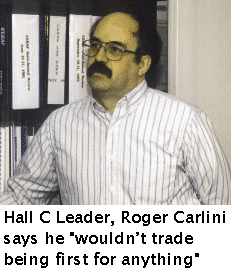 Upon his arrival to CEBAF in 1987, Carlini says the hall was essentially empty of concept and leadership. To make matters worse, there was talk by the Department of Energy of eliminating the end station which was just a drawing on paper.
Upon his arrival to CEBAF in 1987, Carlini says the hall was essentially empty of concept and leadership. To make matters worse, there was talk by the Department of Energy of eliminating the end station which was just a drawing on paper.
"I got involved with Hall C in hopes of ensuring it would continue and in hopes of eventually getting parity experiments into the hall," says Carlini, who became an expert in experimenting during his stint at the Los Alamos Meson Physic Facility in New Mexico. Carlini set out to establish a primary mission for Hall C and to gain critical support for its survival. His solution: offer the nuclear physics community a high-momentum spectrometer and a short path length spectrometer in the experimental hall. Hall C would also support a broad and varied program of scientific initiatives outside the capabilities of Halls A and B.
After some refinement, the user community accepted the idea and provided the necessary support. "They saw it as a flexible facility to train graduate students and do experiments," says Carlini. The user's support came in the form of equipment and 150 physicists on experiment proposals for the first-born hall.
"Hall C fills a niche," says Carlini. "The high-momentum spectrometer and the short orbit spectrometer are highly flexible enabling the equipment to contribute to a varied program." The high-momentum spectrometer (HMS) is designed to reach a very high momentum of 7 GeV. "No other spectrometer on site can do that," says David Mack, a Staff Scientist on the Hall C team.
The short-orbit spectrometer (SOS) detects short-lived particles that may otherwise go undetected. The SOS is unique because its vertical angle can be varied by 20 degrees.
Both spectrometers, says Mack, have good resolution. For the last few weeks the hall has been the site of CEBAF's first experiment, marking the culmination of many years of hard work.
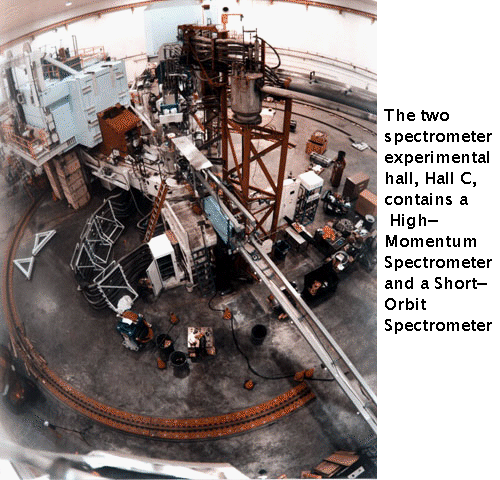
"There was a race to get it where it is today. We followed a very high- paced schedule to meet the deadline," says Carlini. "There was a lot of pressure on me and the group, but I wouldn't trade being first for anything." The work isn't done, however.
The Cryotarget team, led by Joe Mitchell, must work to get the cryotarget operational. The cryotarget is an aluminum flask of flowing liquid hydrogen. Targets of foils are currently being used. Then the team and the users will prepare for the next round of experiments which require new instrumentation-a perfect example of how flexible the equipment in the hall is.
Though the work hasn't come to an end, the team has accomplished a goal envisioned more than a decade ago.
"We're excited, but tired," says Carlini. "I have an excellent staff who came through. We are all feeling a certain satisfaction and some relief from the pressure."
"Now we're ready to have some fun. We came here to do physics, now it's time," adds Carlini. "We're like kids in a candy store ... we just want lots of beam time!"
CEBAF Users Group
Facts
CEBAF's User Community includes scientists, researchers, engineers, teachers, and students. The Users' Group numbers 1,000 and includes scientists from 200 institutions throughout the world. In 1984, the CEBAF Users Group was formed to support CEBAF researchers. The group strives to:
- encourage and assist scientists and engineers in the use of CEBAF
- create and maintain effective communication channels for the exchange of information between the CEBAF staff and others interested in using CEBAF;
- engage effective methods of offering counsel to the CEBAF management on policy affecting facility development and utilization; and
- promote effective use of CEBAF for the benefit of society.
The detectors in the three experimental halls are collaborative efforts by CEBAF users.
To obtain experiment time at CEBAF, researchers submit proposals outlining the type of experiment they wish to perform and the estimated number of "beam hours" they will need. Proposals are reviewed by the Program Advisory Committee (PAC)-a committee of physics experts from universities and laboratories other than CEBAF. With the recommendation of the PAC, the CEBAF Director awards "beam time" to selected proposals.
Joe Wilson
Keeping it Cool
It's an acronym soup that ensures that CEBAF's scientists can conduct their experiments. The CHL - Central Helium Liquifier; ESR - End Station Refrigerator; and CTF - Cryogenic Test Facility, are all cryogenic systems overseen by cryogenic operators like five-year employee Joe Wilson.
Tracking the trends and operations of CEBAF's three cryogenic systems, Wilson, in conjunction with the Cryogenics Group, ensures the delivery of liquid helium to CEBAF's site. In the CHL Control Room (which controls all three systems), thousands of parameters and 30 trend graphs of the systems are displayed and monitored on an array of computer displays.
Complex systems management is nothing new to Wilson whose former specialty was in nuclear propulsion. After graduating from the United States Naval Academy with a Bachelor of Science degree in Mechanical Engineering, Wilson's first duty was the overall supervision of one of two nuclear power plants powering the U.S.S Nimitz.
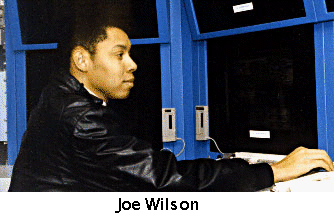
The power plant provided electrical power and steam for the aircraft carrier's main engines and catapults.
Wilson says that he grew up believing that military experience coupled with a solid education was an asset. Born to a former Army officer, his pursuit of a technical education at the Naval Academy had much to do with his childhood in Huntsville, Alabama.
"In the 1960s, Huntsville was the site of a great deal of fabrication and testing for the Apollo program. It [the Apollo program activity] had a great influence on interesting me in engineering. At that time I did not know what an engineer's professional life was like on a day-to-day basis," says Wilson.
After the Navy, he worked at Tenneco Newport News Shipbuilding (TNNS) for 18 months in the Carrier Reactor Plant Planning Yard. The group oversaw modifications to reactor plants in ships under construction or in service. Wilson says he left TNNS to seek new challenges at CEBAF.
On a daily basis Wilson fields constant inquiries from individuals whose work may affect or be affected by the cryogenic system. "Often they call to find out if they can shut down, startup, or test certain sections of their equipment," says Wilson. He says the control room is most hectic when CEBAF recovers from an electrical power failure. Without power, the refrigerators will not keep helium in a liquefied state. Loss of warm compressor operation causes the CHL to shut down and warm up. Relief valves open to release the pressure of expanding helium caused by the loss of refrigeration. Like many members of the Cryogenic Group, Wilson is on a rotating on-call list to satisfy operational demands.
Time pressures arising from crisis situations are a challenge for Wilson who expects to begin a graduate program soon. Wilson admits that while he appreciates his job, the demands of operational unpredictability are trying on his family which includes wife Kimberley, and children, David age 4, and Jennifer age 2. Wilson says that he and his wife will continue to strive to balance work and family.
Will Conners, Directors Office Intern
Cryogenic Basics
The operation of CEBAF depends on a constant, dependable supply of liquefied helium. This supply is generated by repeatedly lowering the temperature of helium until it reaches a liquefied state.
Each of CEBAF's helium refrigerators perform a series of processes to achieve that end. First, warm compressors compress room temperature helium gas to twenty times the normal atmospheric pressure. From there, the helium enters the first of a series of heat exchangers where the helium is cooled to 80 Kelvin or negative 316 °F. Next, turbine expanders, remove a portion of the remaining heat from the gaseous helium until it is cold enough to be converted to a liquid. Gaseous helium flows into cryomodules or magnets where a Joule Thompson valve liquefies a portion of the gas.
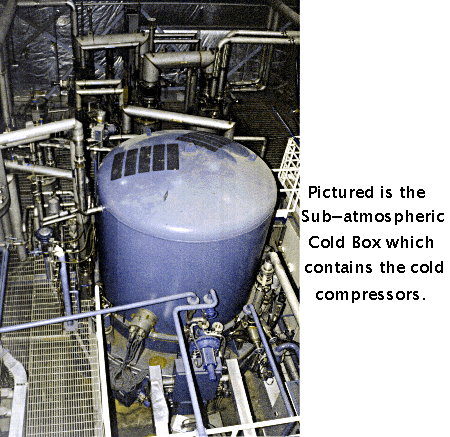
The superconducting cryomodules require liquefied helium at 2 Kelvin to achieve superconductivity; meaning that they are more efficient and less resistant to the conduction of electricity when super cooled. The lessened resistance of the cavities enables the beam to accelerate to higher energies. The heat normally lost to resistance is instead maintained allowing experimenters to use the more powerful beam to efficiently probe nuclei.
Because of their cryogenic systems, cryomodules operate at 2 Kelvin or approximately negative 456 °F. The absolute absence of heat is 0 Kelvin or -460 °F.
CEBAF Salutes Staff
"It is with great satisfaction I acknowledge today, all of you who have contributed so much to CEBAF. Thanks to you and your colleagues we have reached milestone after milestone and are now ready to produce important science for our nation. I salute you all," says Hermann Grunder, CEBAF Director, in congratulating the staff members who have served five and 10 years at CEBAF. On November 1st, CEBAF celebrated these staffers and their collective achievements. What follows is a list of the honorees and photos from the awards ceremony.
|
10 Years of Service as of 1994 David C. Buckle |
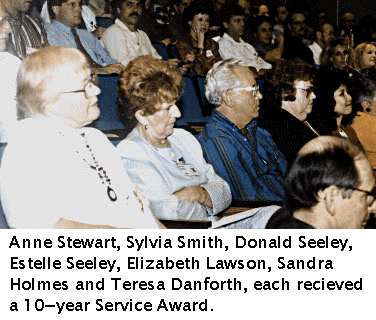 |
|
10 Years of Service as of 1995 George H. Biallas |
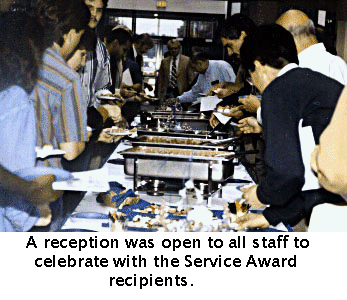 |
|
5 Years of Service as of 1994 Cornelis Apeldoorn |
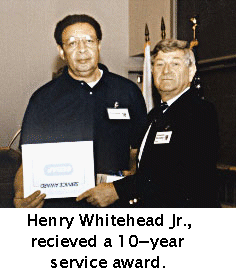 |
|
5 Years of Service as of 1995 David J. Abbott |
|
BRIEFLY . . .
Staff Supports United Way Fund Drive
 Through the generous contributions of staff members, CEBAF has once again exceeded its goal. Our contributions totaled $32,200. Thanks to you, the United Way can continue to carry on its mission of caring.
Through the generous contributions of staff members, CEBAF has once again exceeded its goal. Our contributions totaled $32,200. Thanks to you, the United Way can continue to carry on its mission of caring.
Shilda Williams United Way Campaign Coordinator
CEBAF employees contributed $32,200 to the United Way's 1995 Fund Drive. Seventy-five percent of the contributors chose to earmark their contributions to support specific organizations serviced by the United Way.
CEBAF had an overall 23 percent participation rate among its employees. According to the United Way, eighty-four cents of every dollar contributed is spent supporting over 45 agencies serving the needs of the community.
Dylla Awarded Fellowship
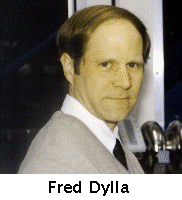 Frederick Dylla, CEBAF's Technology Transfer Manager, was recently named a Fellow of the American Vacuum Society (AVS). The AVS is a non-profit organization dedicated to advancing the science and technology of films and coatings,microelectronics, nanostructures, surfaces and interfaces, plasmas, vacuum, and manufacturing processes.
Frederick Dylla, CEBAF's Technology Transfer Manager, was recently named a Fellow of the American Vacuum Society (AVS). The AVS is a non-profit organization dedicated to advancing the science and technology of films and coatings,microelectronics, nanostructures, surfaces and interfaces, plasmas, vacuum, and manufacturing processes.
The awarding of a fellowship recognizes the recipient as someone who has achieved outstanding scientific and technical contributions in areas of interest to the society. According to the AVS, Dylla's fellowship was granted for "sustained, seminal, scientific contributions to the fields of gas-surface and gas-solid interactions leading to advances in the practice of vacuum arts."
To learn more about the AVS, check out their web site on the Internet at http://www.vacuum.org/.
Going to the Dogs
The CEBAF Boxer Club recently held their first meeting so that the owners could discuss their fondness of the breed and the dogs could engage in some good-natured rough-housing. The club plans to get together again soon after the holidays. If you have a boxer and are interested in joining the club, contact Brian Kross at x7324.
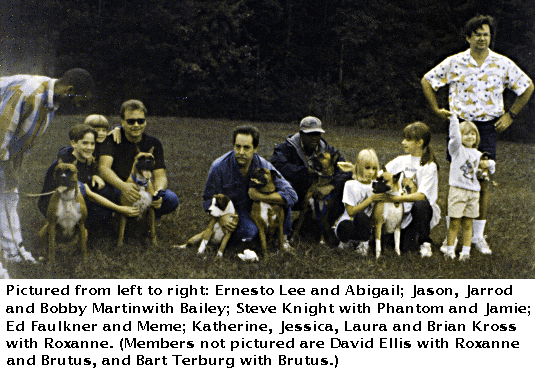
Getting The "SPIN" on Protons
Rutgers University Spearheads Focal Plane Polarimeter Project
Comparing protons to pool balls may not be as far-fetched as it sounds. Some movements a proton makes in travel are similar to those of an eight ball crossing the green felt on its way to the corner pocket.
Recently, the installation of a device that will measure the action of protons was begun in Hall A. The focal plane polarimeter, (FPP), is the result of a large collaborative effort. The FPP was constructed by Rutgers University and the College of William and Mary. Norfolk State University and the University of Georgia were also involved in the project which was funded by the National Science Foundation.
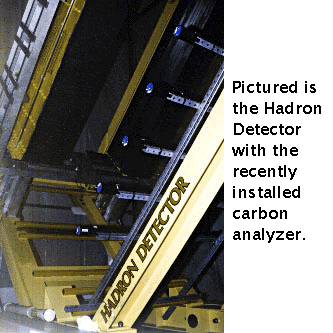 The purpose of the FPP is to measure the polarization of protons in the Hall A hadron spectrometer. The FPP consists of three subsystems including front and rear tracking detectors and a carbon analyzer.
The purpose of the FPP is to measure the polarization of protons in the Hall A hadron spectrometer. The FPP consists of three subsystems including front and rear tracking detectors and a carbon analyzer.
When the electron beam strikes the Hall A target, protons will be emitted. These protons will be focused into a plane by the hadron spectrometer in the hall. The focused plane will then pass through the front two detectors. These detectors will help analyze the "spin" of the proton that is caused when an electron knocks a proton out of one of the target nuclei.
"This spin is very much like the spin that a pool ball might have as it moves across a table," says Paul Rutt, a Rutgers Research Associate who oversaw the partial installation of the FPP. "We are interested in knowing how much of the spin is transferred from the electron to the proton when they interact," he adds.
Both the front tracking detectors and the rear tracking detectors are known as straw chambers. These chambers consist of over 5,000 glued-together straws that are made of aluminum and mylar plastic. Each straw measures one-half inch in diameter and three to six feet in length. A wire, thinner than a human hair, is strung through the exact center of each straw. The straw chambers are able to determine the trajectory of the protons through the use of high-speed electronics when 2,000 volts and a special gas mixture are applied to the wires.
Once the protons have been focused by the spectrometer and their path determined by the two front straw chambers, they then enter the 6,000-pound carbon analyzer. The analyzer consists of large slabs of graphite."The graphite slabs re-scatter the protons. The manner in which theprotonsscatteris determined by thespinoneach proton," says Rutt. After the protons pass through the carbon analyzer, they enter the rear straw chambers which re- analyze their trajectory. "By knowing the proton's trajectory before and after the carbon analyzer, we are able to ascertain its spin. This knowledge is necessary for many of the experiments that will utilize the polarized beam available at CEBAF," claims Rutt.
The initial design and prototyping of the project began at Rutgers and William and Mary in 1991 and fabrication began at both schools in 1993. William and Mary built the front-tracking detectors while Rutgers fabricated the rear- tracking detectors and the carbon analyzer. Many people, from students to department heads, have been involved with the project. "At Rutgers alone, 26 undergrads have provided over 5,000 hours of labor during the construction phase," says Rutt. With the successful installation of the carbon analyzer section of the FPP already completed, concentration is now on completing the fabrication of the straw chambers.
Rutt has a long history working at CEBAF. From 1989 to 1993, he was stationed at CEBAF as a William and Mary graduate student working with the Hall A Group. It was during this time that he first became familiar with the FPP project. "I left Michigan State University to complete my doctorate at William and Mary just for the opportunities at CEBAF," he says. "I'm looking forward to getting beam in Hall A so that we can begin the physics program that the FPP collaboration has waited and worked so long for," Rutt adds.
What's Up With The CRC?
There's no need to wonder what the CEBAF Recreation Committee has planned for the CEBAF community. We've made it easy for all to find out on their own with the help of a new CRC homepage at http://www.jlab.org/news/crc.html. Those with access to the Internet can take advantage of a survey for the recent Holiday Party, e-mail interest groups, and up-to-date information on all up coming activities.
There are other avenues to information as well.
CRC bulletin boards have been strategically placed to provide news of upcoming events.
Call the CRC phone line at extension 4002.
Send a message to the CRC e-mail box at cebaf_crc@jlab.org (the committee will respond to you).
Contact your nearest CRC representative.
Accelerator-Bob Bennett, x7656 (bennettr); Walter Lacy, x6246 (lacy); Eric Woodworth, x7217 (woodworth); Administration-Marty Hightower, x6368 (mhightow); Julie Leverenz, x7642 (leverenz); Danny Lloyd, x7121 (lloyd); Don Seeley, x7570 (seeleyd); Debra Stitts, x7683 (stittsd); Director's Office-Deborah Hyman, chairperson, x4852 (hyman); Office of Tech. Performance-Julie Oyer, x7120 (oyer); Physics-Karen Hokansson, x4861 (kchok); Project Management-Lisa Surles, x5002 (lboone)
CRC Event Calendar
January 8............Bowling League begins
11...........Menchville Choir,CEBAF Center, Free
March
8............Ice Skating Extravaganza, 7:30 p.m. Norfolk Scope, $33; deadline Feb. 2, 1996
Jubliant Gatherings
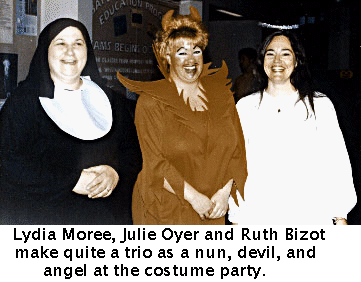
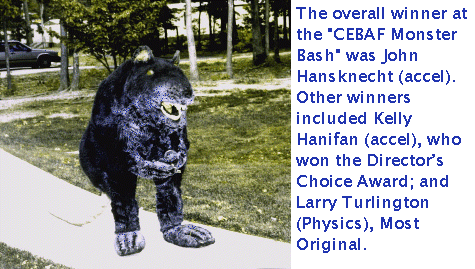
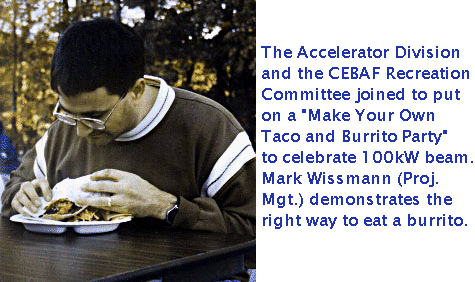
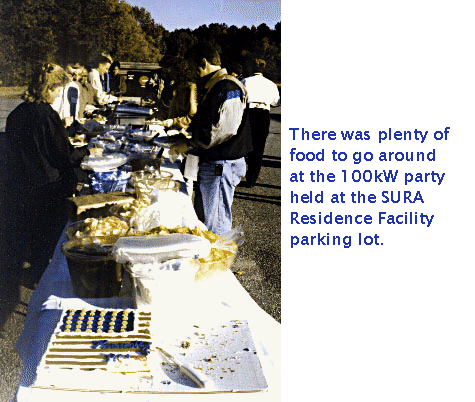
Sign Of The Times
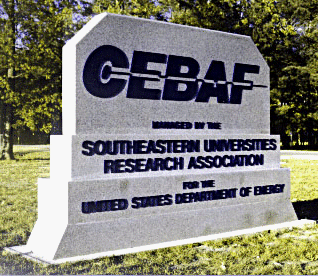
CEBAF finally has a sign to let the public know what exactly is hidden in the woods off of Jefferson Avenue. The new sign consists of a large, gray slab of granite emblazoned with "CEBAF-Blue" lettering. It was designed by Plant Engineering's Christine Snetter and a private firm, Sign Media. Landscaping and lighting are set to be installed around the sign before the Christmas break. "The sign will not only serve as a marker to the main entrance of the facility, but also as an answer to the public's two basic questions about CEBAF: 'What does CEBAF stand for and where is it?' " says Snetter.


